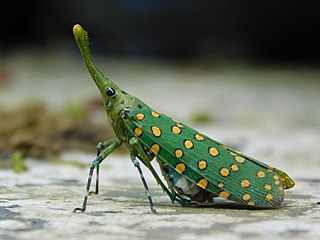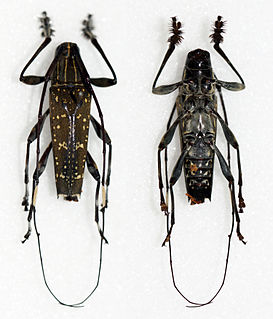Related Research Articles

The small-spotted lizard is a species of lizard. It is found in the following countries: Morocco, Algeria, Tunisia, Libya, Egypt, Sinai, Israel, Saudi Arabia, Iran, India, S. Turkmenistan, N. Africa, Afghanistan, Pakistan, Senegal, Niger, Sudan, Syria. Type locality: Egypt

Saiva is a genus of Asian lanternbugs, family Fulgoridae. They are colourful insects, marked boldly in red, blue, white and black, with a prominent slender stalk like structure arising on the head that points upwards or forward. The known distribution is from India, through Indo-China to Borneo.

The guttulate foliage-gleaner is a species of bird in the family Furnariidae. Until it was pointed out that the word guttulated does not exist in English, it was widely referred to as the guttulated foliage-gleaner. It is endemic to humid forest growing in the Venezuelan Coastal Range.
Pterocalla is a genus of picture-winged flies in the family Ulidiidae.
Pterocalla guttulata is a species of ulidiid or picture-winged fly in the genus Pterocalla of the family Ulidiidae.

Restrepia guttulata, commonly called the small-spotted restrepia, is a species of orchid occurring from Venezuela to Ecuador.
The diamond turbot is a flatfish of the family Pleuronectidae. It is a demersal fish that lives in subtropical waters on sand or mud bottoms at depths of up to 50 metres (160 ft), though it is most commonly found between 1 and 20 metres. Its native habitat is the coastal areas of the eastern Pacific, from Cape Mendocino, California in the north to Baja California in Mexico in the south. The turbot is dark green with light blue spots. It reaches up to 46 centimetres (18 in) in length, and its maximum reported lifespan is 9 years.

Colobotheini is a tribe of longhorn beetles of the subfamily Lamiinae.

Colobothea is a genus of longhorn beetles of the subfamily Lamiinae.
Eczemotes is a genus of longhorn beetles of the subfamily Lamiinae, containing the following species:
Colobothea decemmaculata is a species of beetle in the family Cerambycidae. It was described by Bates in 1865. It is known from Brazil and French Guiana.
Colobothea pimplaea is a species of beetle in the family Cerambycidae. It was described by Bates in 1865. It is known from Brazil, French Guiana, and Peru.
Colobothea discicollis is a species of beetle in the family Cerambycidae. It was described by Gahan in 1889. It is known from Brazil.
Autosticha guttulata is a moth in the family Autostichidae. It was described by Edward Meyrick in 1925. It is found in China.

Eunidia guttulata is a species of beetle in the family Cerambycidae. It was described by Charles Coquerel in 1851, originally under the genus Sphenura.
Corrhenes guttulata is a species of beetle in the family Cerambycidae. It was described by Francis Polkinghorne Pascoe in 1865. It is known from Australia.
Trigonoptera guttulata is a species of beetle in the family Cerambycidae. It was described by Gestro in 1876, originally under the genus Arsysia.

Ephemera guttulata or the eastern green drake is a species of mayfly in the genus Ephemera. The eastern green drake is native to the continental United States and Canada. Its conservation status per the NatureServe conservation status ranking system is G5, meaning it is secure.

Ephemera simulans is a species of mayfly. It is commonly found throughout the United States. The species is used for fly fishing.
Calcipostia is a monotypic genus of fungi belonging to the family Fomitopsidaceae. The only species is Calcipostia guttulata.
References
- ↑ BioLib.cz - Colobothea guttulata. Retrieved on 8 September 2014.